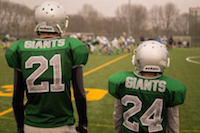 The sunshine gleaming on fire-engine red seats; the ear-splitting roars of 75,000 fans; the extravagant spectacle of a half-time show; the inevitable shrill shrieks of whistles and heart jarring thuds of bodies colliding…it’s almost time for Super Bowl 50! But all is not fun and games. American football, at both the amateur and professional levels,has been under scrutiny, with much of the focus on athlete’s heads and how best to protect them. Inventions, including BrainShield decals and a University of Pennsylvania color-changing polymer, may be the wave of the future for detecting severity of a TBI right on the field. The release of the movie “Concussion” and the family announcement that Frank Gifford died with Chronic Traumatic Encephalopathy (CTE), have given further impetus to the development of such products. But does more or better protection necessarily equate to fewer and potentially less devastating traumas? What about sports like soccer and rugby that compare in physicality, but whose athletes use much less protective gear?
The sunshine gleaming on fire-engine red seats; the ear-splitting roars of 75,000 fans; the extravagant spectacle of a half-time show; the inevitable shrill shrieks of whistles and heart jarring thuds of bodies colliding…it’s almost time for Super Bowl 50! But all is not fun and games. American football, at both the amateur and professional levels,has been under scrutiny, with much of the focus on athlete’s heads and how best to protect them. Inventions, including BrainShield decals and a University of Pennsylvania color-changing polymer, may be the wave of the future for detecting severity of a TBI right on the field. The release of the movie “Concussion” and the family announcement that Frank Gifford died with Chronic Traumatic Encephalopathy (CTE), have given further impetus to the development of such products. But does more or better protection necessarily equate to fewer and potentially less devastating traumas? What about sports like soccer and rugby that compare in physicality, but whose athletes use much less protective gear?
Erik Swartz, University of New Hampshire Professor of Kinesiology, former football athletic trainer and rugby player, had been asking himself these very same questions. Statistics for head injuries in rugby, a helmetless but very physical sport, were much lower in comparison to football. Removing the protection, he concluded must be making players, consciously or subconsciously, more risk adverse, and proceeded to persuade one college football coach to test out his theory. The results of the study, published in The Journal of Athletic Training, seem to give strong credence to his supposition. Players without helmets tackled with more caution during training, an instinct that then and carried over to game time. The study is being replicated at the high school level and if those yield the same results, can the NFL then lag in changing decades of coaching rituals and potentially avoid career ending and life-changing traumas for their athletes?
Food for thought…especially for all you PTs out there on the receiving end of those CTEs/TBIs.